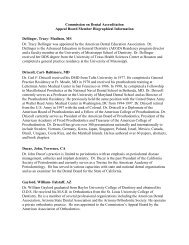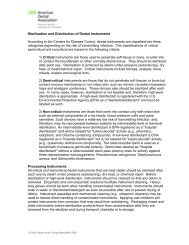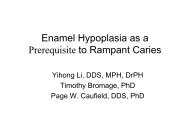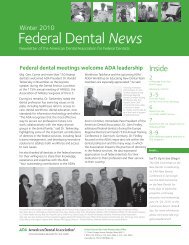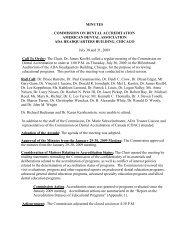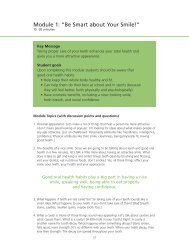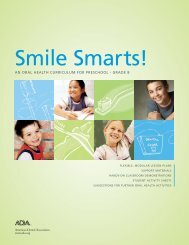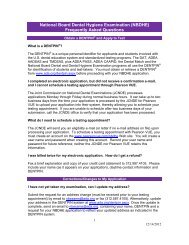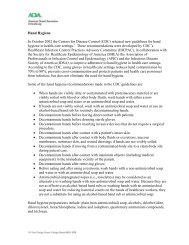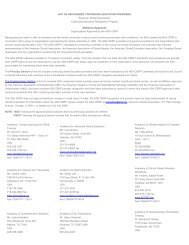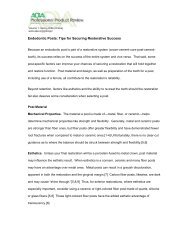Chemotherapeutic Products for the Control of Gingivitis - American ...
Chemotherapeutic Products for the Control of Gingivitis - American ...
Chemotherapeutic Products for the Control of Gingivitis - American ...
Create successful ePaper yourself
Turn your PDF publications into a flip-book with our unique Google optimized e-Paper software.
<strong>Chemo<strong>the</strong>rapeutic</strong> <strong>Products</strong> <strong>for</strong> <strong>Control</strong> <strong>of</strong> <strong>Gingivitis</strong>, July 2008 9<br />
Methods should be selected that measure gingivitis using both subjective and objective criteria. That is, gingivitis will be<br />
evaluated using an index <strong>of</strong> gingival bleeding (e.g., Eastman Interdental Bleeding Index), coupled with ei<strong>the</strong>r a purely visuallybased<br />
gingivitis index or, alternately, a comprehensive gingivitis index which incor-porates both bleeding and visual<br />
appearance, e.g., Löe & Silness (Acta Odon 1963 21:533). O<strong>the</strong>r indices in addition to those mentioned above that have<br />
been shown to measure gingival health may also be used. Justification <strong>for</strong> <strong>the</strong> particular gingival indices used must be<br />
provided.<br />
The gingival indices used should be simple to use with a minimum <strong>of</strong> time and expense; criteria <strong>for</strong> assessing <strong>the</strong> stages <strong>of</strong><br />
gingivitis should be clear and understandable; <strong>the</strong> clinical manifestations <strong>of</strong> <strong>the</strong> disease process should be measurable at all<br />
stages; and <strong>the</strong> data from <strong>the</strong> index should be amenable to statistical treatment. Accurate indices should be used to assess<br />
<strong>the</strong> proper severity <strong>of</strong> <strong>the</strong> condition and <strong>the</strong> localized effects <strong>of</strong> treatment.<br />
C Statistical Analysis<br />
Mean group whole mouth scores <strong>for</strong> plaque and gingivitis on all surfaces will be compared at baseline, 6 months, and at an<br />
intermediate period with appropriate statistical tests in at least one study. Ramfjord teeth may be used <strong>for</strong> any additional<br />
studies. If more than two groups are being evaluated appropriate multiple comparison tests should be used. The basis <strong>for</strong><br />
statistical sizing must be provided in <strong>the</strong> protocol. In<strong>for</strong>mation to be provided includes expected examiner variance, <strong>the</strong><br />
targeted alpha and beta values, <strong>the</strong> estimated drop out rate, and <strong>the</strong> targeted treatment differences.<br />
Basic documentation should include summary statistics <strong>of</strong> outcomes and potentially important prognostic variables, by<br />
treatment. In multi-center trials, <strong>the</strong>se should be reported separately <strong>for</strong> each participating center, as well as <strong>for</strong> all centers<br />
combined.<br />
If <strong>the</strong> trial employs stratified randomization in <strong>the</strong> design, <strong>the</strong> analysis should reflect this. The distributions <strong>of</strong> important<br />
prognostic factors should be compared across treatment groups, and statistical adjustment employed where disparities in<br />
prognostic variables may have seriously influenced outcome comparisons. In multi-centered trials, <strong>the</strong> possibility and nature<br />
<strong>of</strong> treatment by center interactions should be examined. Among many possible technical approaches to statistical analysis,<br />
analyses <strong>of</strong> variance or covariance, original categorical analyses, and rank analyses are typically considered. Mention <strong>of</strong><br />
<strong>the</strong>se approaches by no means precludes use <strong>of</strong> o<strong>the</strong>r techniques as appropriate to <strong>the</strong> study design and variables<br />
employed. Although whole-mouth mean scores are traditionally used in <strong>the</strong> primary analyses <strong>of</strong> gingivitis trials, site-specific<br />
data (e.g., from <strong>the</strong> interdental papillae) may provide additional in<strong>for</strong>mation <strong>of</strong> special clinical relevance <strong>for</strong> some products, in<br />
which case <strong>the</strong>y may also be tracked and suitably analyzed. Analyses <strong>of</strong> separate observations at individual sites should<br />
appropriately account <strong>for</strong> correlations <strong>of</strong> site-based measurements within <strong>the</strong> same subject.<br />
Safety Assessments<br />
A Oral S<strong>of</strong>t Tissue Assessment<br />
Refer to Section 8 a. Safety assessments must be made at each measurement period.<br />
B Oral Hard Tissue Assessment<br />
Refer to Section 8 b. Safety assessments must be made at each measurement period.<br />
C Toxicology Assessment<br />
Refer to Section 8 c.



